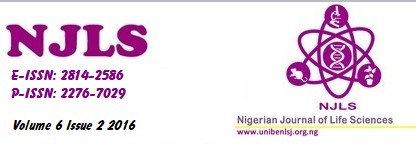BACTERIAL FLORA OF CATFISH (Clarias gariepinus) FROM FISH PONDS IN LAGOS STATE, NIGERIA
DOI:
https://doi.org/10.52417/njls.v6i2.327Keywords:
Clarias gariepinus, Salmonella, Staphylococcus, coliformsAbstract
Fish is a very important component of human diet. A total of 64 samples of Clarias gariepinus were collected from two fish ponds each in Yaba, Ijegun, Ikorodu and Epe in Lagos State, Nigeria. The bacterial flora of the fishes were determined quantitatively and qualitatively. The mean total viable count ranged from log10 7.6 cfu/g to log10 7.9 cfu/g. The bacterial load on the skin and in the intestine were generally higher than in the gills. Salmonella count ranged between log10 7.2 cfu/g and log10 7.6 cfu/g and it was highest in the intestine, followed by skin and gills. Coliform count was higher in the intestine and on the skin than the gills with range values of log10 7.6 cfu/g) to log10 7.9 cfu/g. Staphylococcal count was highest on the skin than the intestine and gills. The range of count was log10 7.2 cfu/g in the gills to log10 7.6 cfu/g on the skin. The bacteria isolated were identified based on cultural, morphological and biochemical characterization using Analytical Profile Index and they include Pseudomonas aeruginosa, Klebsiella pneumoniae, Salmonella typhi, Citrobacter amalonaticus, Vibrio fluvialis, Serratia odorifera, Acinetobacter baumannii, Proteus penneri, Burkholderia cepacia, Enterobacter pyrinus, Salmonella enteritidis, Edwardsiella tarda, Escherichia coli, Pseudomonas putida, Bacillus megaterium, Staphylococcus aureus, Bacillus mycoides, Corynebacterium pilosum, Bacillus subtilis, Micrococcus roseus, Bacillus cereus, Bacillus polymyxa, Micrococcus leteus and Corynebacterium kutscheri. The occurrence of pathogenic bacteria may constitute public health hazard

Published
Issue
Section
License
Copyright (c) 2016 https://www.unibenlsj.org.ng/index.php/njls

This work is licensed under a Creative Commons Attribution 4.0 International License.





